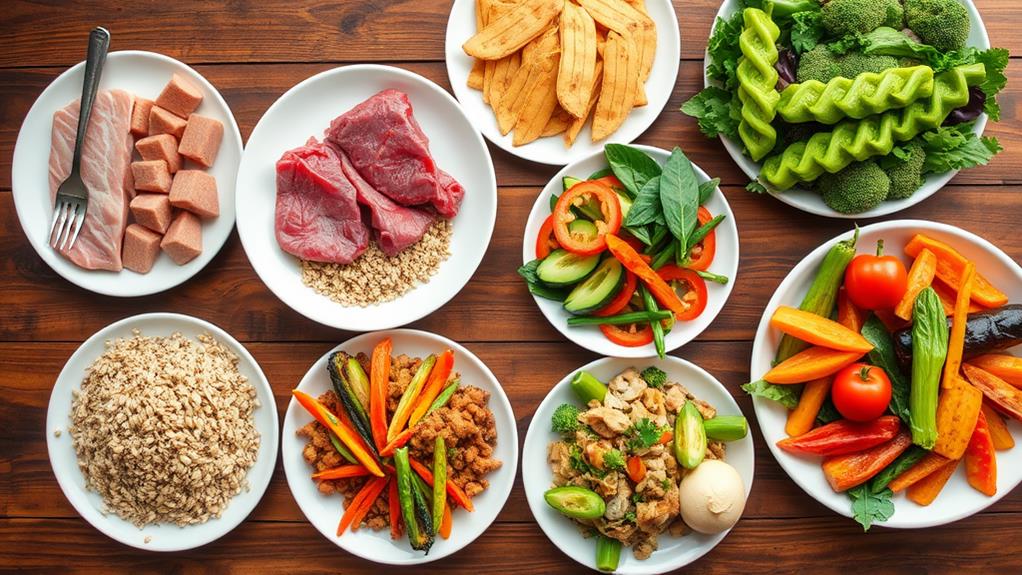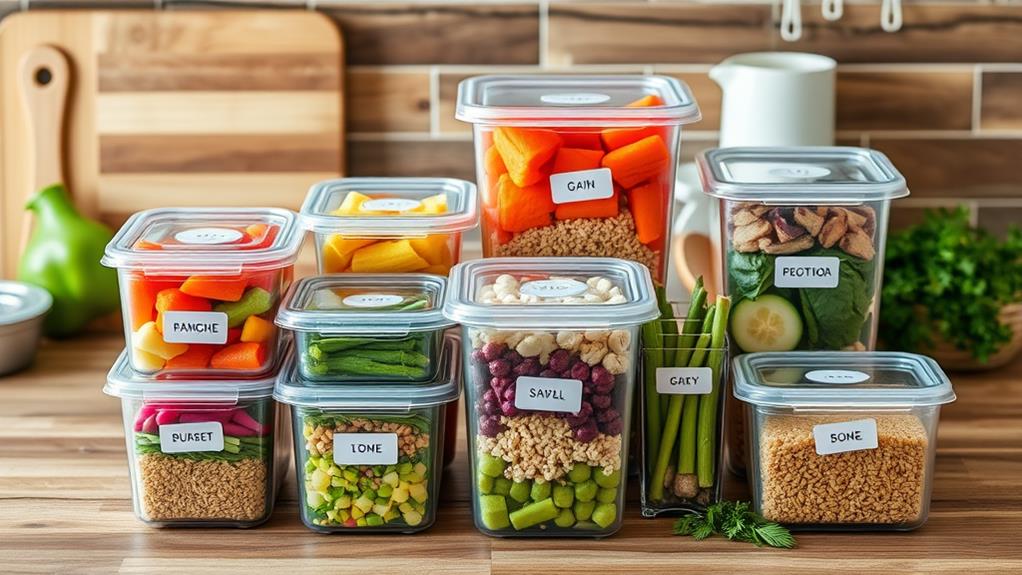In the age of fast food and instant gratification, creating a nutritious weekly menu might feel like a Herculean task. But it doesn’t have to be overwhelming; with a few strategic choices, you can set yourself up for success. Think about how you can prioritize whole foods and incorporate variety to enhance your meals. There are key strategies to ensure you’re not just eating, but nourishing your body effectively. Curious about the specifics? Let’s explore how to simplify your meal planning while maximizing health benefits.
Plan Your Meals Ahead

Planning your meals ahead can significantly enhance your nutrition and save you time during the week. When you engage in meal prepping, you reduce the impulse to opt for unhealthy convenience foods. By dedicating a few hours each week to prepare nutritious meals, you can ensure that you have balanced options readily available.
Start by creating a weekly menu that incorporates a variety of proteins, vegetables, and whole grains. This not only keeps your meals interesting but also ensures you’re getting a wide range of nutrients. Once you’ve planned your meals, make a comprehensive grocery shopping list based on those recipes. Stick to this list to avoid unnecessary purchases and temptations.
When you shop, focus on whole foods, such as fresh produce, lean meats, and whole grains. Having these items on hand makes it easier to stick to your meal plan.
After grocery shopping, set aside time to cook and portion out your meals for the week. Store them in clear containers for easy access. This approach not only promotes healthier eating habits but also streamlines your week, allowing you to enjoy your meals without the stress of last-minute cooking.
Incorporate Variety and Color
To create meals that are both nutritious and appealing, you should focus on incorporating a variety of colors and textures. Research shows that colorful fruits and vegetables not only enhance the visual appeal of your dishes but also provide a broader spectrum of nutrients. Aim for a rainbow on your plate; each color often represents different vitamins and minerals essential for your health.
Start with colorful salads, using greens like spinach and kale, then add vibrant ingredients such as cherry tomatoes, bell peppers, and shredded carrots. These not only boost flavor but also maximize nutrient intake.
Additionally, don’t underestimate the power of vibrant smoothies. Blend leafy greens with fruits like berries, mangoes, and bananas for a nutrient-packed drink that’s both delicious and satisfying.
Incorporating a variety of textures is equally important. Combine crunchy nuts or seeds with creamy avocado or soft cheese in your meals to keep things interesting.
Balance Macronutrients Properly

Balancing macronutrients properly is crucial for maintaining energy levels and overall health. To achieve this balance, you need to focus on the three main macronutrients: carbohydrates, proteins, and fats. Each plays a vital role in your diet. Aim for a well-rounded plate that includes a variety of each macronutrient.
Start with protein sources like lean meats, fish, legumes, and dairy. These foods help build and repair tissues while keeping you feeling full.
Next, incorporate healthy fats from sources such as avocados, nuts, and olive oil. These fats support cell function and hormone production, contributing to your overall well-being.
Don’t forget about carbohydrates! Choose whole grains, fruits, and vegetables to provide essential vitamins and minerals, along with fiber for digestive health.
A rough guideline is to allocate about 30% of your daily calories to protein, 30% to healthy fats, and 40% to carbohydrates, but adjust based on your personal needs.
Make Use of Seasonal Ingredients
Incorporating seasonal ingredients into your meals can significantly enhance both flavor and nutrition. By choosing fruits and vegetables that are in season, you support local farmers and ensure that you’re consuming fresher, more flavorful produce.
Seasonal recipes often highlight the natural tastes of these ingredients, making your meals more enjoyable and satisfying.
Here are four benefits of using seasonal ingredients:
- Better Taste: Seasonal produce is harvested at its peak ripeness, resulting in superior flavor compared to out-of-season items.
- Higher Nutritional Value: Freshly picked fruits and vegetables retain more nutrients, giving you a healthier meal.
- Cost-Effective: Seasonal ingredients are often more affordable due to their abundance, allowing you to save money while eating well.
- Environmental Impact: Supporting local farmers reduces transportation emissions and promotes sustainable agriculture.
Prepare and Store in Batches

Using seasonal ingredients can make meal preparation even more efficient when you prepare and store in batches. Batch cooking allows you to maximize your time in the kitchen, minimizing daily cooking stress.
Start by selecting a day to cook, like Sunday, and choose recipes that share similar ingredients, which helps reduce waste and costs.
When meal prepping, focus on versatile dishes that can be easily transformed throughout the week. For example, a large batch of roasted vegetables can be used in salads, wraps, or as side dishes.
Cook grains like quinoa or brown rice in bulk, as they serve as excellent bases for multiple meals.
Proper storage is key to maintaining the quality of your meals. Invest in airtight containers to keep food fresh and organized.
Label your containers with the date and contents to streamline your weekly meals.
Conclusion
By weaving these five tips into your weekly menu, you’ll create a vibrant tapestry of nutrition that fuels both body and soul. Planning meals ahead turns chaos into harmony, while colorful ingredients dance on your plate, offering a feast for the eyes and health. Balancing macronutrients ensures you’re not just eating, but thriving. Seasonal ingredients add a touch of nature’s whimsy, and batch cooking transforms stress into simplicity. Embrace this culinary journey, and savor the delicious benefits every day!














